Mingyu Li
A Case for Declarative LLM-friendly Interfaces for Improved Efficiency of Computer-Use Agents
Oct 06, 2025Abstract:Computer-use agents (CUAs) powered by large language models (LLMs) have emerged as a promising approach to automating computer tasks, yet they struggle with graphical user interfaces (GUIs). GUIs, designed for humans, force LLMs to decompose high-level goals into lengthy, error-prone sequences of fine-grained actions, resulting in low success rates and an excessive number of LLM calls. We propose Goal-Oriented Interface (GOI), a novel abstraction that transforms existing GUIs into three declarative primitives: access, state, and observation, which are better suited for LLMs. Our key idea is policy-mechanism separation: LLMs focus on high-level semantic planning (policy) while GOI handles low-level navigation and interaction (mechanism). GOI does not require modifying the application source code or relying on application programming interfaces (APIs). We evaluate GOI with Microsoft Office Suite (Word, PowerPoint, Excel) on Windows. Compared to a leading GUI-based agent baseline, GOI improves task success rates by 67% and reduces interaction steps by 43.5%. Notably, GOI completes over 61% of successful tasks with a single LLM call.
Communications to Circulations: 3D Wind Field Retrieval and Real-Time Prediction Using 5G GNSS Signals and Deep Learning
Sep 19, 2025



Abstract:Accurate atmospheric wind field information is crucial for various applications, including weather forecasting, aviation safety, and disaster risk reduction. However, obtaining high spatiotemporal resolution wind data remains challenging due to limitations in traditional in-situ observations and remote sensing techniques, as well as the computational expense and biases of numerical weather prediction (NWP) models. This paper introduces G-WindCast, a novel deep learning framework that leverages signal strength variations from 5G Global Navigation Satellite System (GNSS) signals to retrieve and forecast three-dimensional (3D) atmospheric wind fields. The framework utilizes Forward Neural Networks (FNN) and Transformer networks to capture complex, nonlinear, and spatiotemporal relationships between GNSS-derived features and wind dynamics. Our preliminary results demonstrate promising accuracy in both wind retrieval and short-term wind forecasting (up to 30 minutes lead time), with skill scores comparable to high-resolution NWP outputs in certain scenarios. The model exhibits robustness across different forecast horizons and pressure levels, and its predictions for wind speed and direction show superior agreement with observations compared to concurrent ERA5 reanalysis data. Furthermore, we show that the system can maintain excellent performance for localized forecasting even with a significantly reduced number of GNSS stations (e.g., around 100), highlighting its cost-effectiveness and scalability. This interdisciplinary approach underscores the transformative potential of exploiting non-traditional data sources and deep learning for advanced environmental monitoring and real-time atmospheric applications.
A Survey of Context Engineering for Large Language Models
Jul 17, 2025Abstract:The performance of Large Language Models (LLMs) is fundamentally determined by the contextual information provided during inference. This survey introduces Context Engineering, a formal discipline that transcends simple prompt design to encompass the systematic optimization of information payloads for LLMs. We present a comprehensive taxonomy decomposing Context Engineering into its foundational components and the sophisticated implementations that integrate them into intelligent systems. We first examine the foundational components: context retrieval and generation, context processing and context management. We then explore how these components are architecturally integrated to create sophisticated system implementations: retrieval-augmented generation (RAG), memory systems and tool-integrated reasoning, and multi-agent systems. Through this systematic analysis of over 1300 research papers, our survey not only establishes a technical roadmap for the field but also reveals a critical research gap: a fundamental asymmetry exists between model capabilities. While current models, augmented by advanced context engineering, demonstrate remarkable proficiency in understanding complex contexts, they exhibit pronounced limitations in generating equally sophisticated, long-form outputs. Addressing this gap is a defining priority for future research. Ultimately, this survey provides a unified framework for both researchers and engineers advancing context-aware AI.
Designing Cyclic Peptides via Harmonic SDE with Atom-Bond Modeling
May 27, 2025Abstract:Cyclic peptides offer inherent advantages in pharmaceuticals. For example, cyclic peptides are more resistant to enzymatic hydrolysis compared to linear peptides and usually exhibit excellent stability and affinity. Although deep generative models have achieved great success in linear peptide design, several challenges prevent the development of computational methods for designing diverse types of cyclic peptides. These challenges include the scarcity of 3D structural data on target proteins and associated cyclic peptide ligands, the geometric constraints that cyclization imposes, and the involvement of non-canonical amino acids in cyclization. To address the above challenges, we introduce CpSDE, which consists of two key components: AtomSDE, a generative structure prediction model based on harmonic SDE, and ResRouter, a residue type predictor. Utilizing a routed sampling algorithm that alternates between these two models to iteratively update sequences and structures, CpSDE facilitates the generation of cyclic peptides. By employing explicit all-atom and bond modeling, CpSDE overcomes existing data limitations and is proficient in designing a wide variety of cyclic peptides. Our experimental results demonstrate that the cyclic peptides designed by our method exhibit reliable stability and affinity.
Deciphering the unique dynamic activation pathway in a G protein-coupled receptor enables unveiling biased signaling and identifying cryptic allosteric sites in conformational intermediates
Apr 24, 2025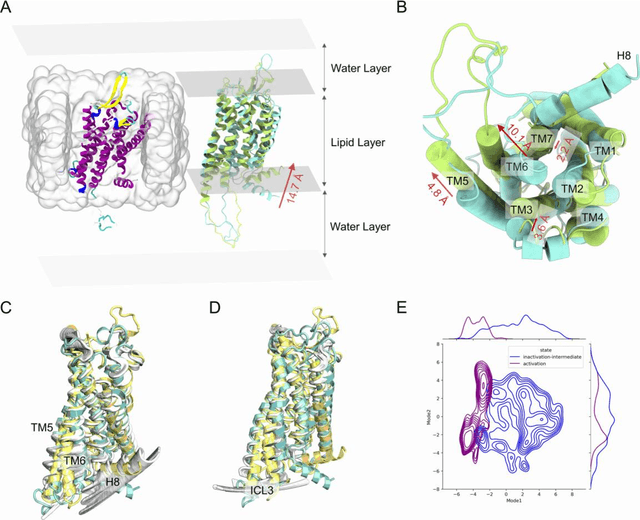
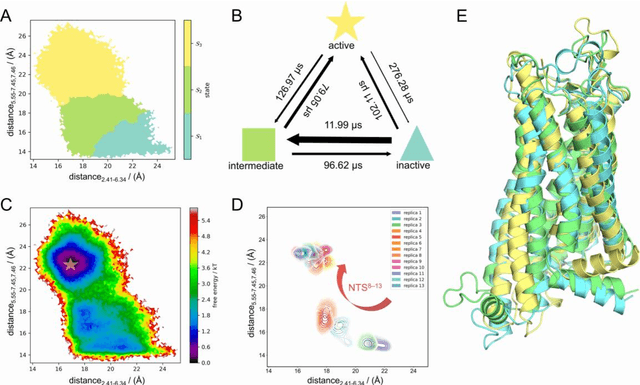
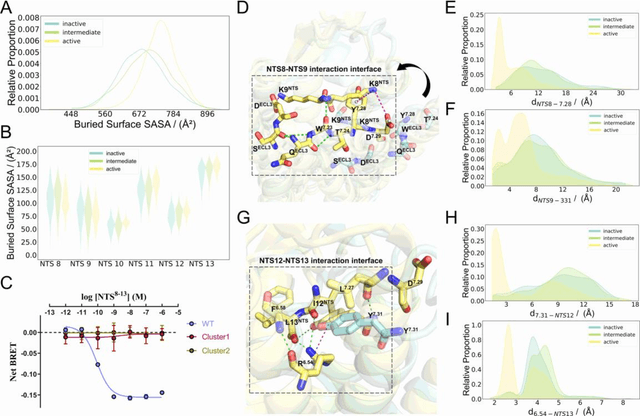
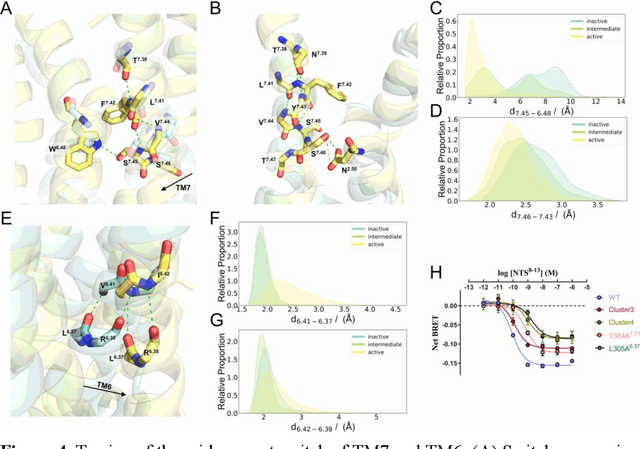
Abstract:Neurotensin receptor 1 (NTSR1), a member of the Class A G protein-coupled receptor superfamily, plays an important role in modulating dopaminergic neuronal activity and eliciting opioid-independent analgesia. Recent studies suggest that promoting \{beta}-arrestin-biased signaling in NTSR1 may diminish drugs of abuse, such as psychostimulants, thereby offering a potential avenue for treating human addiction-related disorders. In this study, we utilized a novel computational and experimental approach that combined nudged elastic band-based molecular dynamics simulations, Markov state models, temporal communication network analysis, site-directed mutagenesis, and conformational biosensors, to explore the intricate mechanisms underlying NTSR1 activation and biased signaling. Our study reveals a dynamic stepwise transition mechanism and activated transmission network associated with NTSR1 activation. It also yields valuable insights into the complex interplay between the unique polar network, non-conserved ion locks, and aromatic clusters in NTSR1 signaling. Moreover, we identified a cryptic allosteric site located in the intracellular region of the receptor that exists in an intermediate state within the activation pathway. Collectively, these findings contribute to a more profound understanding of NTSR1 activation and biased signaling at the atomic level, thereby providing a potential strategy for the development of NTSR1 allosteric modulators in the realm of G protein-coupled receptor biology, biophysics, and medicine.
PathSeqSAM: Sequential Modeling for Pathology Image Segmentation with SAM2
Apr 12, 2025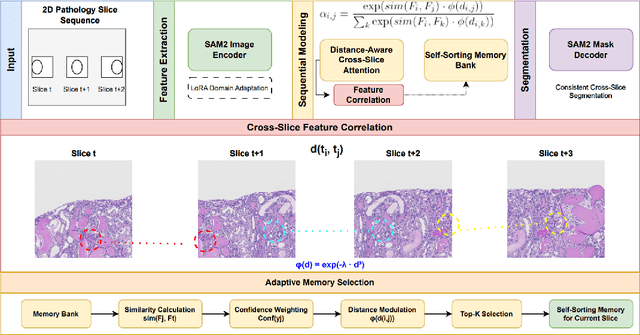
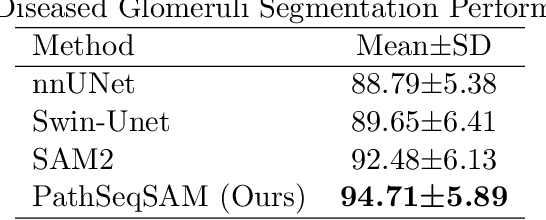
Abstract:Current methods for pathology image segmentation typically treat 2D slices independently, ignoring valuable cross-slice information. We present PathSeqSAM, a novel approach that treats 2D pathology slices as sequential video frames using SAM2's memory mechanisms. Our method introduces a distance-aware attention mechanism that accounts for variable physical distances between slices and employs LoRA for domain adaptation. Evaluated on the KPI Challenge 2024 dataset for glomeruli segmentation, PathSeqSAM demonstrates improved segmentation quality, particularly in challenging cases that benefit from cross-slice context. We have publicly released our code at https://github.com/JackyyyWang/PathSeqSAM.
F$^3$low: Frame-to-Frame Coarse-grained Molecular Dynamics with SE Guided Flow Matching
May 01, 2024



Abstract:Molecular dynamics (MD) is a crucial technique for simulating biological systems, enabling the exploration of their dynamic nature and fostering an understanding of their functions and properties. To address exploration inefficiency, emerging enhanced sampling approaches like coarse-graining (CG) and generative models have been employed. In this work, we propose a \underline{Frame-to-Frame} generative model with guided \underline{Flow}-matching (F$3$low) for enhanced sampling, which (a) extends the domain of CG modeling to the SE(3) Riemannian manifold; (b) retreating CGMD simulations as autoregressively sampling guided by the former frame via flow-matching models; (c) targets the protein backbone, offering improved insights into secondary structure formation and intricate folding pathways. Compared to previous methods, F$3$low allows for broader exploration of conformational space. The ability to rapidly generate diverse conformations via force-free generative paradigm on SE(3) paves the way toward efficient enhanced sampling methods.
1Cademy @ Causal News Corpus 2022: Leveraging Self-Training in Causality Classification of Socio-Political Event Data
Nov 04, 2022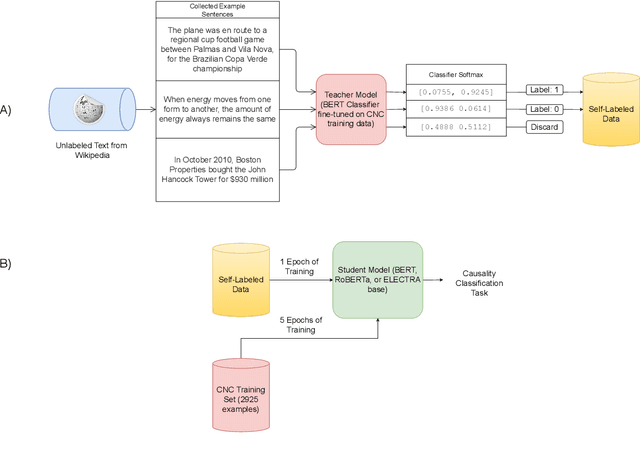
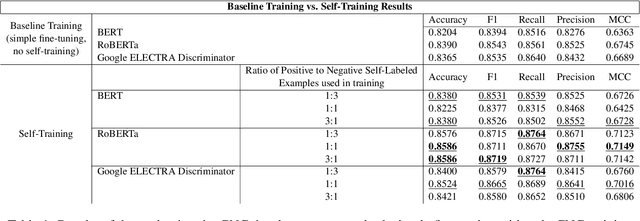
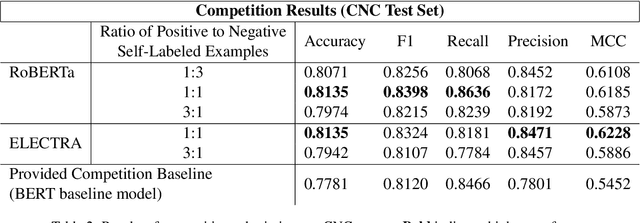
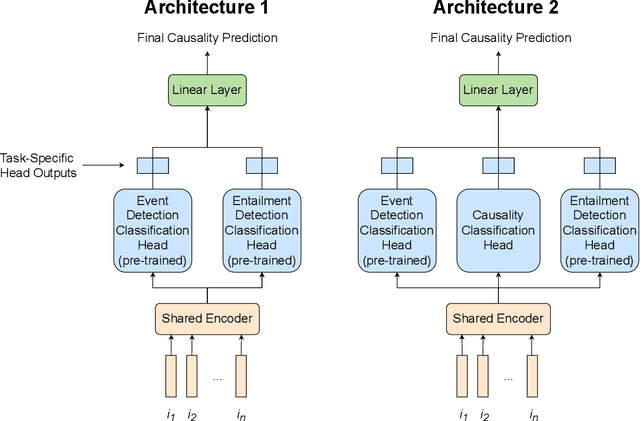
Abstract:This paper details our participation in the Challenges and Applications of Automated Extraction of Socio-political Events from Text (CASE) workshop @ EMNLP 2022, where we take part in Subtask 1 of Shared Task 3. We approach the given task of event causality detection by proposing a self-training pipeline that follows a teacher-student classifier method. More specifically, we initially train a teacher model on the true, original task data, and use that teacher model to self-label data to be used in the training of a separate student model for the final task prediction. We test how restricting the number of positive or negative self-labeled examples in the self-training process affects classification performance. Our final results show that using self-training produces a comprehensive performance improvement across all models and self-labeled training sets tested within the task of event causality sequence classification. On top of that, we find that self-training performance did not diminish even when restricting either positive/negative examples used in training. Our code is be publicly available at https://github.com/Gzhang-umich/1CademyTeamOfCASE.
1Cademy @ Causal News Corpus 2022: Enhance Causal Span Detection via Beam-Search-based Position Selector
Oct 31, 2022



Abstract:In this paper, we present our approach and empirical observations for Cause-Effect Signal Span Detection -- Subtask 2 of Shared task 3~\cite{tan-etal-2022-event} at CASE 2022. The shared task aims to extract the cause, effect, and signal spans from a given causal sentence. We model the task as a reading comprehension (RC) problem and apply a token-level RC-based span prediction paradigm to the task as the baseline. We explore different training objectives to fine-tune the model, as well as data augmentation (DA) tricks based on the language model (LM) for performance improvement. Additionally, we propose an efficient beam-search post-processing strategy to due with the drawbacks of span detection to obtain a further performance gain. Our approach achieves an average $F_1$ score of 54.15 and ranks \textbf{$1^{st}$} in the CASE competition. Our code is available at \url{https://github.com/Gzhang-umich/1CademyTeamOfCASE}.
 Add to Chrome
Add to Chrome Add to Firefox
Add to Firefox Add to Edge
Add to Edge